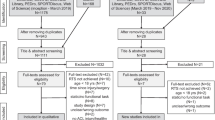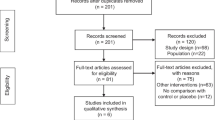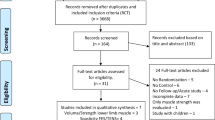Abstract
Electromyographic biofeedback (EMG-BF) has been applied to treat different types of peripheral nerve injuries (PNI). However, despite the clinical practice widespread use its evidence is controversial. With the objective of summarize the available evidence on the electromyographic biofeedback effectiveness and efficacy to help motor function recovery after PNI an integrative review was performed. A secondary objective was to identify the conceptual framework and strategies of EMG-BF intervention, and the quality of technical description of EMG-BF procedures. To conduct this integrative review a systematic search of the literature was performed between October 2013 and July 2018, in PUBMED, ISI and COCHRANE databases for EMG-BF original studies in PNI patients of any etiology, in English, Portuguese, Spanish or French, published after 1990. Exclusion criteria were poor description of EMG-BF treatment, associated treatment that could impair EMG-BF effect, inclusion of non-PNI individuals and case studies design. The PEDro scale was used to evaluate study quality of randomized clinical trials (RCTs) included. This resulted in 71 potential articles enrolled to full reading, although only nine matched the inclusion criteria. PNI included facial paralysis, acute sciatic inflammation and carpal tunnel syndrome. The average quality score of the included RCTs was five, corresponding to low methodological quality. Due to the small number of included articles, low quality studies and heterogeneity of interventions, outcomes and population we concluded that there is limited evidence of EMG-BF effectiveness and efficacy for motor function recovery in PNI patients.

Similar content being viewed by others
References
Adigüzel, E., Yaşar, E., Tecer, D., Güzelküçük, Ü, Taşkaynatan, M. A., Kesikburun, S., & Özgül, A. (2016). Peripheral nerve injuries: Long term follow-up results of rehabilitation. Journal of Back and Musculoskeletal Rehabilitation, 1, 1–5. https://doi.org/10.3233/BMR-160681.
Azuma, T., Nakamura, K., Takahashi, M., Ohyama, S., Toda, N., Iwasaki, H., et al. (2012). Mirror biofeedback rehabilitation after administration of single-dose botulinum toxin for treatment of facial synkinesis. Otolaryngology: Head and Neck Surgery, 146(1), 40–45. https://doi.org/10.1177/0194599811424125.
Brach, J. S., VanSwearingen, J. M., Lenert, J., & Johnson, P. C. (1997). Facial neuromuscular retraining for oral synkinesis. Plastic and Reconstructive Surgery. https://doi.org/10.1097/00006534-199706000-00018.
Cardoso, J. R., Teixeira, E. C., Moreira, M. D., Fontes, S. V., de Oliveira, A. S. B., & Favero, F. M. (2008). Effects of exercises on Bell’s Palsy: Systematic review of randomized controlled trials. Otology & Neurology, 29, 557–560.
Chiu, H.-Y., Hsu, H.-Y., Su, F.-C., Jou, I.-M., Lin, C.-F., & Kuo, L.-C. (2013). Setup of a novel biofeedback prototype for sensorimotor control of the hand and preliminary application in patients with peripheral nerve injuries. Physical Therapy, 93(2), 168–178. https://doi.org/10.2522/ptj.20120050.
Chung, K., Yang, L., & McGillicuddy, J. (2012). Practical management of pediatric and adult brachial plexus palsies (1st ed.). London: Elsevier. Retrieved February 9, 2015, from http://www.amazon.com/Practical-Management-Pediatric-Brachial-Palsies/dp/1437705758/ref=sr_1_1?ie=UTF8&qid=1423448577&sr=8-1&keywords=brachial+chung.
Criswell, E. (2011). Cram’s introduction to surface electromyography. Training.
Cronin, G. W., & Steenerson, R. L. (2003). The effectiveness of neuromuscular facial retraining combined with electromyography in facial paralysis rehabilitation. Otolaryngology–Head and Neck Surgery, 128(4), 534–538. https://doi.org/10.1016/mhn.2003.110.
Dalla Toffola, E., Bossi, D., Buonocore, M., Montomoli, C., Petrucci, L., & Alfonsi, E. (2005). Usefulness of BFB/EMG in facial palsy rehabilitation. Disability and Rehabilitation, 27, 809–815. https://doi.org/10.1080/09638280400018650.
Dalla Toffola, E., & Tinelli, C., Lozza, A., Bejor, M., Pavese, C. D., Degli Agosti, I. & Petrucci, L. (2012). Choosing the best rehabilitation treatment for Bell’s Palsy. European Journal of Physical and Rehabilitation Medicine, 48(4), 635–642.
De Albornoz, P. M., Delgado, P. J., Forriol, F., & Maffulli, N. (2011). Non-surgical therapies for peripheral nerve injury. British Medical Bulletin, 100(1), 73–100. https://doi.org/10.1093/bmb/ldr005.
DenBrinker, P., & Vanwieringen, P. (1988). Den Brinker_EMG feedback in rehabilitation following surgical treatment of nerve lesions in the lower arm.pdf. International Journal of the Rabilitation Research, 3(11), 269–272.
Dobson, J. L., McMillan, J., & Li, L. (2014). Benefits of exercise intervention in reducing neuropathic pain. Frontiers in Cellular Neuroscience, 8, 102. https://doi.org/10.3389/fncel.2014.00102.
Dubravica, M., Musura, M., & Nesek-Madaric, V. (1996). Treatment of facial palsy by EMG biofeedback technique. Muscle relaxation technique. Acta Clinica Croatica, 35(1–2), 17–20.
Duff, S. V. (2005). Impact of peripheral nerve injury on sensorimotor control. Journal of Hand Therapy: Official Journal of the American Society of Hand Therapists, 18(2), 277–291. https://doi.org/10.1197/j.jht.2005.02.007.
Ferreira, A. S. (2006). Lesões nervosas periféricas: Diagnóstico e tratamento (2nd ed.). São Paulo: Santos livraria e editora.
Fox, I., & Mackinnon, S. (2012). Adult peripheral nerve disorders—nerve entrapment, repair, transfer and brachial plexus disorders. Plastic and Reconstructive Surgery, 29(5), 997–1003. https://doi.org/10.1016/j.biotechadv.2011.08.021.Secreted.
Ginanneschi, F., Mondelli, M., & Rossi, A. (2012). Sensory neuropathy may cause central neuronal reorganization but does not respecify perceptual quality or localization of sensation. The Clinical Journal of Pain, 28(8), 653–657. https://doi.org/10.1097/AJP.0b013e3182430589.
Harris-Adamson, C., Eisen, E. A., Kapellusch, J., Garg, A., Hegmann, K. T., Thiese, M. S., et al. (2015). Biomechanical risk factors for carpal tunnel syndrome: A pooled study of 2474 workers. Occupational and Environmental Medicine, 72(1), 33–41. https://doi.org/10.1136/oemed-2014-102378.
Hasenbring, M., Ulrich, H. W., Hartmann, M., & Soyka, D. (1999). The efficacy of a risk factor-based cognitive behavioral intervention and electromyographic biofeedback in patients with acute sciatic pain. An attempt to prevent chronicity. Spine, 24(23), 2525–2535. https://doi.org/10.1097/00007632-199912010-00015.
Hermens, H. J., Freriks, B., Disselhorst-Klug, C., & Rau, G. (2000). Development of recommendations for SEMG sensors and sensor placement procedures. Journal of Electromyography and Kinesiology, 10, 361–374. https://doi.org/10.1016/S1050-6411(00)00027-4.
Ince, L. P., & Brenes Jette, C. C. (1987). EMG biofeedback to patients with Guillain-Barré syndrome. Rehabilitation Psychology, 32(3), 155–163. https://doi.org/10.1037/h0091570.
Kasman, G. S., Cram, J. R., & Wolf, S. L. (1998). Clinical applications in surfaceelectromyography: Chronic musculoskeletal pain (1st ed.). Gaithersburg: Aspen Publishers.
Kinlaw, D. (2005). Pre-/postoperative therapy for adult plexus injury. Hand Clinics, 21(1), 103–108. https://doi.org/10.1016/j.hcl.2004.10.003.
Kirdi, N., Yakut, E., & Meriç, A. (1998). Peroneal nerve injuries as a complication of injection. The Turkish Journal of Pediatrics, 40(3), 405–411. Retrieved February 9, 2015, from http://www.ncbi.nlm.nih.gov/pubmed/9763905.
Kunz, R., & Oxman, A. D. (1998). The unpredictability paradox: Review of empirical comparisons of randomised and non-randomised clinical trials. BMJ (Clinical Research Editions), 317, 1185–1190. https://doi.org/10.1136/bmj.317.7167.1185.
Lauber, B., & Keller, M. (2012). Improving motor performance: Selected aspects of augmented feedback in exercise and health. European Journal of Sport Science, 14, 1–8. https://doi.org/10.1080/17461391.2012.725104.
Lee, M., Wong, M., Tang, F., Chang, W., & Chiou, W. (1996). Design and assessment of an adaptive intermittent cervical traction modality with EMG biofeedback. Journal of Biomechanical Engineering, 4(118), 597–600.
Macedo, L. G., Elkins, M. R., Maher, C. G., Moseley, A. M., Herbert, R. D., & Sherrington, C. (2010). There was evidence of convergent and construct validity of physiotherapy evidence database quality scale for physiotherapy trials. Journal of Clinical Epidemiology, 63(8), 920–925. https://doi.org/10.1016/j.jclinepi.2009.10.005.
Maher, C. G., Sherrington, C., Herbert, R. D., Moseley, A. M., & Elkins, M. (2003). Reliability of the PEDro scale for rating quality of randomized controlled trials. Physical therapy, 83, 713–721.
Manca, M., Contenti, E., Mura, G., Basaglia, N., C. L (1997). EMG biofeedback in peripheral facial nerve palsy rehabilitation. Europa Medicophysica, 33(3), 143–147.
Massé-Alarie, H., Beaulieu, L. D., Preuss, R., & Schneider, C. (2016). Corticomotor control of lumbar multifidus muscles is impaired in chronic low back pain: Concurrent evidence from ultrasound imaging and double-pulse transcranial magnetic stimulation. Experimental Brain Research, 234(4), 1033–1045. https://doi.org/10.1007/s00221-015-4528-x.
Moher, D., Pham, B., Jones, A., Cook, D. J., Jadad, A. R., Moher, M., et al. (1998). Does quality of reports of randomised trials affect estimates of intervention efficacy reported in meta-analyses? The Lancet, 352, 609–613. https://doi.org/10.1016/S0140-6736(98)01085-X.
Novak, C. B. (2004). Rehabilitation strategies for facial nerve injuries. Seminars in Plastic Surgery, 18(1), 47–52. https://doi.org/10.1055/s-2004-823123.
Novak, C. B. (2008). Rehabilitation following motor nerve transfers. Hand Clinics, 24(4), 417–423. https://doi.org/10.1016/j.hcl.2008.06.001.
Oud, T., Beelen, A., Eijffinger, E., & Nollet, F. (2007). Sensory re-education after nerve injury of the upper limb: A systematic review. Clinical Rehabilitation, 21(6), 483–494. https://doi.org/10.1177/0269215507074395.
Peirce, C., Murphy, C., Fitzpatrick, M., Cassidy, M., Daly, L., Connell, P. R. O., & Herlihy, C. O. (2013). Randomised controlled trial comparing early home biofeedback physiotherapy with pelvic floor exercises for the treatment of third-degree tears (EBAPT trial). BJOG: An International Journal of Obstetrics and Gynaecology, 10(120), 1240–1247. https://doi.org/10.1111/1471-0528.12194.
Pieber, K., Herceg, M., & Paternostro-Sluga, T. (2010). Electrotherapy for the treatment of painful diabetic peripheral neuropathy: A review. Journal of Rehabilitation Medicine: Official Journal of the UEMS European Board of Physical and Rehabilitation Medicine, 42(18), 289–295. https://doi.org/10.2340/16501977-0554.
Pourmomeny, A. A., Asadi, S., & Cheatsaz, A. (2015). Management of facial synkinesis with a combination of BTX-A and biofeedback: A randomized trial. Iranian Journal of Otorhinolaryngology, 27(6), 409–415.
Pourmomeny, A. A., Zadmehre, H., Mirshamsi, M., & Mahmodi, Z. (2014). Prevention of synkinesis by biofeedback therapy: A randomized clinical trial. Otology & Neurotology: Official Publication of the American Otological Society, American Neurotology Society [and] European Academy of Otology and Neurotology, 35, 739–742. https://doi.org/10.1097/MAO.0000000000000217.
Ross, B., Nedzelski, J. M., & McLean, J. A. (1991). Efficacy of feedback training in long-standing facial nerve paresis. The Laryngoscope. https://doi.org/10.1288/00005537-199107000-00009.
Schulz, K. F., Chalmers, I., Hayes, R. J., & Altman, D. G. (1995). Empirical evidence of bias. Dimensions of methodological quality associated with estimates of treatment effects in controlled trials. JAMA: The Journal of the American Medical Association, 273(5), 408–412. https://doi.org/10.1097/00043764-199603000-00007.
Segal, B., Zompa, I., Danys, I., Black, M., Shapiro, M., Melmed, C., & Arthurs, B. (1995). Symmetry and synkinesis during rehabilitation of unilateral facial paralysis. The Journal of Otolaryngology. https://doi.org/10.2144/05384CI01.
Shen, Z. L., & Li, Z.-M. (2013). Biomechanical interaction between the transverse carpal ligament and the thenar muscles. Journal of Applied Physiology, 114(2), 225–229. https://doi.org/10.1152/japplphysiol.01273.2012.
Shiau, J., Segal, B., Danys, I., Freedman, R., & Scott, S. (1995). Long-term effects of neuromuscular rehabilitation of chronic facial paralysis. The Journal of Otolaryngology, 24, 217–220.
Smania, N., Berto, G., La Marchina, E., Melotti, C., Midiri, A., Roncari, L., et al. (2012). Rehabilitation of brachial plexus injuries in adults and children. European Journal of Physical and Rehabilitation Medicine, 48(3), 483–506. http://www.ncbi.nlm.nih.gov/pubmed/23075907.
Stafford, M. a., Peng, P., & Hill, D. a. (2007). Sciatica: A review of history, epidemiology, pathogenesis, and the role of epidural steroid injection in management. British Journal of Anaesthesia, 99(4), 461–473. https://doi.org/10.1093/bja/aem238.
Stein, C., Eibel, B., Sbruzzi, G., Lago, P. D., & Plentz, R. D. (2013). Electrical stimulation and electromagnetic field use in patients with diabetic neuropathy: Systematic review and meta-analysis. Revista Brasileira de Fisioterapia, 17(2), 93–104. https://doi.org/10.1590/s1413-35552012005000083.
Teixeira, L. J., Soares, B. G. D. O., Vieira, V. P., & Prado, G. F. (2008). Physical therapy for Bell s palsy (idiopathic facial paralysis). Cochrane Database of Systematic Reviews (Online). https://doi.org/10.1002/14651858.CD006283.pub2.
Terzis, J. K., & Karypidis, D. (2012a). Therapeutic strategies in post-facial paralysis synkinesis in adult patients. Plastic and Reconstructive Surgery, 6(129), 925–939. https://doi.org/10.1097/PRS.0b013e318230e758.
Terzis, J. K., & Karypidis, D. (2012b). Therapeutic strategies in post-facial paralysis synkinesis in pediatric patients. British Journal of Plastic Surgery, 65(8), 1009–1018. https://doi.org/10.1016/j.bjps.2012.03.026.
Thomas, R. E., Vaidya, S. C., Herrick, R. T., & Congleton, J. J. (1993). The effects of biofeedback on carpal tunnel syndrome. Ergonomics, 36, 353–361. https://doi.org/10.1080/00140139308967892.
Toth, C., Brady, S., Gagnon, F., & Wigglesworth, K. (2014). A randomized, single-blind, controlled, parallel assignment study of exercise versus education as adjuvant in the treatment of peripheral neuropathic pain. The Clinical Journal of Pain, 30(2), 111–118. https://doi.org/10.1097/AJP.0b013e31828ccd0f.
Tsao, H., Danneels, L., & Hodges, P. W. (2012). ISSLS prize winner smudging the motor brain in young adults with recurrent low back pain. Spine, 37(17), 1490–1496. https://doi.org/10.1097/BRS.0b013e3182608ac4.
Tsao, H., Galea, M. P., & Hodges, P. W. (2008). Reorganization of the motor cortex is associated with postural control deficits in recurrent low back pain. Brain, 131(8), 2161–2171. https://doi.org/10.1093/brain/awn154.
Tsao, H., Galea, M. P., & Hodges, P. W. (2010). Driving plasticity in the motor cortex in recurrent low back pain. European Journal of Pain, 14(8), 832–839. https://doi.org/10.1016/j.ejpain.2010.01.001.
Tsao, H., Tucker, K. J., & Hodges, P. W. (2011). Changes in excitability of corticomotor inputs to the trunk muscles during experimentally-induced acute low back pain. Neuroscience, 181, 127–133. https://doi.org/10.1016/j.neuroscience.2011.02.033.
Vanswearingen, J. (2008). Facial rehabilitation: A neuromuscular reeducation, patient-centered approach. Facial Plastic Surgery: FPS, 24(2), 250–259. https://doi.org/10.1055/s-2008-1075841.
Vaz, K. M., Brown, J. M., Shah, S. B., & Ph, D. (2015). Peripheral nerve lengthening as a regenerative strategy. Neuron Regeneration Research, 16(9), 1–5.
Vearrier, L. A., Langan, J., Shumway-Cook, A., & Woollacott, M. (2005). An intensive massed practice approach to retraining balance post-stroke. Gait and Posture, 22(2), 154–163. https://doi.org/10.1016/j.gaitpost.2004.09.001.
Verhagen, A. P., De Vet, H. C. W., De Bie, R. a., Kessels, A. G. H., Boers, M., Bouter, L. M., & Knipschild, P. G. (1998). The Delphi list: A criteria list for quality assessment of randomized clinical trials for conducting systematic reviews developed by Delphi consensus. Journal of Clinical Epidemiology, 51(12), 1235–1241. https://doi.org/10.1016/S0895-4356(98)00131-0.
Volk, G. F., Finkensieper, M., & Guntinas-Lichius, O. (2014). EMG biofeedback training at home for patient with chronic facial palsy and defective healing. Laryngo- Rhino- Otologie, 93(1), 15–24. https://doi.org/10.1055/s-0033-1345166.
Wong, A., Lee, M., Chang, W., & Tang, F. (1997). Clinical trial of a cervical traction modality with electromyography. American Journal of Physical Medicine & Rehabilitation, 1(76), 19–25.
You, D., Smith, A. H., & Rempel, D. (2014). Meta-analysis: Association between wrist posture and carpal tunnel syndrome among workers. Safety and Health at Work, 5(1), 27–31. https://doi.org/10.1016/j.shaw.2014.01.003.
Funding
First author has received research grant from Coordination for the Improvement of Higher Education Personnel (CAPES) (Demanda Social; portaria CAPES no. 76 de 14/04/2010) as support to attend a master degree program. The Functional Electroestimulation Laboratory provided the facility, equipment and material necessary for the study.
Author information
Authors and Affiliations
Corresponding author
Ethics declarations
Conflict of interest
The authors declare that they have no conflict of interest.
Research Involving Human Participants and/or Animals
This article does not contain any studies with human participants or animals performed by any of the authors.
Appendix 1
Appendix 1
Search Strategy
(Biofeedback OR biofeedback emg OR emg biofeedback OR electromyography biofeedback OR electromyographic biofeedback OR muscle biofeedback OR feedback emg OR emg feedback OR electromyography feedback OR electromyographic feedback OR myo feedback OR biofeedback) AND (neuromuscular disease OR peripheral nerve injury OR peripheral nerve lesion OR nerve lesion OR nerve injury OR nerve crush OR neurotization OR nerve transfer OR neurorrhaphy OR bell palsy OR bell idiopathic OR facial nerve OR median nerve OR ulnar nerve OR medial nerve OR femoral nerve OR fibular nerve OR sciatic OR isquiatic OR neuropathy OR neuropathies OR brachial plexus lesion) NOT (laboratory animal study OR rats OR rat OR mouse OR mice OR habit OR stroke OR neurofeedback).
Rights and permissions
About this article
Cite this article
Duarte-Moreira, R.J., Castro, K.VF., Luz-Santos, C. et al. Electromyographic Biofeedback in Motor Function Recovery After Peripheral Nerve Injury: An Integrative Review of the Literature. Appl Psychophysiol Biofeedback 43, 247–257 (2018). https://doi.org/10.1007/s10484-018-9403-7
Published:
Issue Date:
DOI: https://doi.org/10.1007/s10484-018-9403-7




